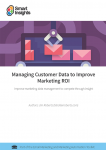Marrying logic and magic pushes campaigns beyond the marketing noise
Today’s savvy consumers require authentic connections at precise points in the buying cycle. Brands that fail to consistently hit that mark will struggle to keep up. Instead of adding value, they end up just creating a busier, more confusing market. Finding these key points of connection requires you to get serious about data.
Nevertheless, data without a vision is like a bad teacher just quoting the textbook: It’s all there, but there’s no meaningful connection. Additionally, bad data costs the typical company up to a fifth of its revenue each year. It takes a human vision to challenge the data, ask the right questions, explore different scenarios, and extract meaningful insights to inform the creative output. And when creatives and data analysts work together from the beginning, logic meets magic, and that vision gets much stronger.
Creating a union made in marketing heaven
Look to Spotify for the perfect example of a company harnessing user data for fantastic and creative marketing campaigns. Using actual user data from the Spotify app, the company initiated a new phase of its data-driven campaign that consists of outdoor billboards suggesting humorous 2018 goals, such as skipping a dinner invite because the host added certain songs to his playlist. This campaign is not only timely, but it also connects individual data points to broader cultural insights.
Like Spotify, companies shouldn’t wait to unite the powerful forces of data and creativity.
By focusing on the following three strategies, companies can realize and optimize their marketing campaigns:
1. Mix up your teams to build a data-centric culture
Change challenges us, and the more diverse a team is that’s working on a project, the richer your data readings and interpretations. Put creatives and data analysts together to brainstorm, and mix up resources often to generate a variety of ideas. This will have several effects:
- When analyzing the data together, creatives and data analysts can play with it, diving beneath the surface and looking for unexpected correlations. At an early stage in the marketing process, this collaboration can lead to unique and powerful insights, and it also tends to reveal new data sources and signals that complement the analysis, such as location or weather information.
- Creating space for the data team to share inspirations with the agency helps data insights transcend creative briefs. Creatives can and should learn a lot from project performance analysis, understanding which emotional triggers performed better for a particular audience. And data analysts can use these learnings to refine the strategy and improve the connected engagement platform.
- Celebrating campaigns with fresh and meaningful data insights and recognizing the teams who made them encourages creatives to view data in two ways: as an exciting strategy for evolving marketing campaigns and as a challenge to turn the numbers into something relatable for consumers. Likewise, companies that stress how data scientists can benefit from working with creatives help their data teams better understand how human behaviors might drive the numbers they’re analyzing.
2. Dig for the human behaviors driving the data
Marketers must understand the emotions underlying data. Creatives have a good sensibility for human truths and pain points, and data analysts know how to match different data sources to interpret and map these human truths. Marketing is about finding and engaging a target audience, but data helps us perceive and understand those audiences more efficiently than in the past. And data and creative teams who understand precise, connected engagement as a shared goal will unlock greater campaign success.
Entertainment platform Netflix and Seamless, a New York-based food delivery service app, are two examples of companies maximizing this collaboration:
- By harnessing user data to drive informed insights and build targeted series like “Orange Is the New Black” and “Stranger Things,” Netflix then uses its data to promote those series to the right audience with the right message. The success of this strategy can be seen in the company’s 100 million users and 58% growth in share prices in 2017.
- Like Netflix, Seamless taps into user data to create original and creative content. The company recently created a “Special Instructions” campaign that singles out some of the most complicated user instructions. These authentic, human, and humorous videos and posters, which are placed inside NYC subway trains, feel less like advertisements and more like skillfully told stories that fold users into the advertising process.
Ultimately, creating communications at a scale that work on an individual level renders a strong bond between brands and consumers, who feel the brand just gets them.
3. Make data accessible for more insights
Your data teams shouldn’t be the only ones able to interpret that data. Otherwise, you’ll lose out on insights that clients, customers, and other team members can glean.
Promoting data insight workshops with clients and third-party data vendors, as well as internal teams throughout other vested divisions — like sales, customer service, or relevant executives — fosters greater collaboration while bringing to the table a valuable point of view. For example, sales teams can provide an intimate industry knowledge and customer service teams can give insights into product usage or service.
Beyond these comprehensive insights, this collaboration also helps maintain data transparency. Helping all teams see how the data is sourced, how frequently it’s refreshed, and how the segments are built engenders a greater understanding of the value data provides.
Snickers have one of the most interesting data-to-end-users projects: its global Hungerithm campaign. This connected engagement project adjusts the price of Snickers in stores according to real-time internet sentiment analysis, with nearly 150 updates in a day and discounts sometimes exceeding 80 percent. The analysis of social sentiment combined with pricing highlights Snickers’ brand concept and leads users to an in-store purchase while making them feel in control of the customer experience, as they get to share data in real time.
Same game, new world
An ex-insurance agent once explained that prior to each visit he’d scour the newspapers for fresh conversation topics; research the potential buyer’s life, including the hobbies, sports, and lifestyle the buyer was into; and then, just before ringing the doorbell, he’d look around the property, identifying any personal triggers that could better shape the upcoming conversation. Today’s data-driven insights allow marketers to do the same legwork, only much faster and for hundreds or thousands of potential customers all at once.
A marketer’s goal is to create a personalized, memorable experience that builds brand loyalty and engages each individual through his interests, passions, or problems. Doing so isn’t a data-versus-creativity conundrum; rather, it’s a data-plus-creativity solution. So stop guessing whether your efforts mean something to potential buyers and start measuring. Then take your measurements and search for the human meaning behind the numbers, testing, creating, and measuring some more until you set a new gold standard of driving connected engagement.


